|
|
|
|
Getting started
Understanding your network type
Typically, you can only have one connection between your computer and the machine at a time.
Wireless network name and network password
Wireless networks require higher security, so when an access point is first set up, a network name (SSID), the type of security used, and a Network Password are created for the network. Ask your network administrator about this information before proceeding with the machine installation.
Introducing wireless set up methods
You can set wireless settings either from the machine or the computer. Choose the setting method from the below table.
|
|
|
|
Some wireless network installation types may not be available depending on the model or country. |
|
Set up method |
Connecting method |
Description & Reference |
|---|---|---|
|
With Access Point 
|
From the computer 
|
Windows user, see Access point via USB cable. |
|
Windows user, see Access point without a USB cable (recommended). |
||
|
||
|
From the machine’s control panel 
|
||
|
Without Access Point 
|
From the computer 
|
Windows user, see Ad hoc via USB cable. |
|
Mac user, see Ad hoc via USB cable. |
||
|
Wi-Fi Direct setup 
|
|
|
|
|
Using the WPS button
If your machine and an access point (or wireless
router) support Wi-Fi Protected Setup™ (WPS), you
can easily configure the wireless network settings by pressing the  (WPS) button
on the control panel without a computer.
(WPS) button
on the control panel without a computer.
|
|
|
|
Items to prepare
-
Check if the access point (or wireless router) supports Wi-Fi Protected Setup™ (WPS).
-
Check if your machine supports Wi-Fi Protected Setup™ (WPS).
-
Networked computer (PIN mode only)
Choosing your type
There are two methods available to connect your machine to
a wireless network using the  (WPS) button
on the control panel.
(WPS) button
on the control panel.
The Push Button Configuration (PBC) method
allows you to connect your machine to a wireless network by pressing
both the  (WPS) button
on the control panel of your machine and the WPS (PBC) button
on a Wi-Fi Protected Setup™ WPS-enabled
access point (or wireless router) respectively.
(WPS) button
on the control panel of your machine and the WPS (PBC) button
on a Wi-Fi Protected Setup™ WPS-enabled
access point (or wireless router) respectively.
The Personal Identification Number (PIN) method helps you connect your machine to a wireless network by entering the supplied PIN information on a Wi-Fi Protected Setup™ WPS-enabled access point (or wireless router).
Factory default in your machine is PBC mode, which is recommended for a typical wireless network environment.
|
|
|
|
If your machine doesn’t have a display screen, you can enable or disable the Wi-Fi Direct feature with the button.
|
|
|
|
|
You can change the WPS mode in control panel ( |
Machines with a display screen
-
Press and hold the
 (WPS) button
on the control panel for more than 2 seconds.
(WPS) button
on the control panel for more than 2 seconds.The machine starts waiting for up to two minutes until you press the WPS (PBC) button on the access point (or wireless router).
-
Press the WPS (PBC) button on the access point (or wireless router).
The messages are displayed on the display screen in the order below:
-
: The machine is connecting to the access point (or wireless router).
-
: When the machine is successfully connected to the wireless network, the WPS LED light stays on.
-
: After completing the wireless network connection process, the AP’s SSID information appears on the display.
-
-
Insert the supplied software CD into your CD-ROM drive, and follow the instructions in the window to set up the wireless network.
-
Press and hold the
 (WPS) button
on the control panel for more than 2 seconds.
(WPS) button
on the control panel for more than 2 seconds. -
The eight-digit PIN appears on the display.
You need to enter the eight-digit PIN within two minutes on the computer that is connected to the access point (or wireless router).
The messages are displayed on the display screen in the order below:
-
: The machine is connecting to the wireless network.
-
: When the machine is successfully connected to the wireless network, the WPS LED light stays on.
-
: After completing the wireless network connection process, the AP’s SSID information is displayed on the LCD display.
-
-
Insert the supplied software CD into your CD-ROM drive, and follow the instructions in the window to set up the wireless network.

Machines without a display screen
-
Press and hold the
 (WPS) button
on the control panel for about 2 - 4 seconds until the
status LED blinks quickly.
(WPS) button
on the control panel for about 2 - 4 seconds until the
status LED blinks quickly.The machine starts connecting to the wireless network. The LED blinks slowly for up to two minutes until you press the PBC button on the access point (or wireless router).
-
Press the WPS (PBC) button on the access point (or wireless router).
-
The light blinks fast on the WPS LED. The machine is connecting to the access point (or wireless router).
-
When the machine is successfully connected to the wireless network, the WPS LED light stays on.
-
-
Insert the supplied software CD into your CD-ROM drive, and follow the instructions in the window to set up the wireless network.

-
The network configuration report, including PIN, must be printed (see Printing a network configuration report).
In ready mode, Press the
 ( or ) button
for more than five seconds on the control panel.
( or ) button
for more than five seconds on the control panel. The machine without the
 ( or ) button: Press
the ()
( or ) button: Press
the () button
for more than ten seconds on the control panel.
button
for more than ten seconds on the control panel. You can find your machine’s PIN.
-
Press and hold the
 (WPS) button
on the control panel for more than 4 seconds until the status LED
stays on.
(WPS) button
on the control panel for more than 4 seconds until the status LED
stays on.The machine starts connecting to the access point (or wireless router).
-
You need to enter the eight-digit PIN within two minutes on the computer that is connected to the access point (or wireless router).
The LED blinks slowly for up to two minutes until you enter the eight-digit PIN.
The WPS LED blinks in the order below:
-
The light blinks fast on the WPS LED. The machine is connecting to the access point (or wireless router).
-
When the machine is successfully connected to the wireless network, the WPS LED light stays on.
-
-
Insert the supplied software CD into your CD-ROM drive, and follow the instructions in the window to set up the wireless network.

Re-connecting to a network
When the wireless function is off, the machine automatically tries to re-connect to the access point (or wireless router) with the previously used wireless connection settings and address.
|
|
|
|
In the following cases, the machine automatically re-connects to the wireless network:
|
Canceling the connection process
To cancel the wireless network connection when the machine
is connecting to the wireless network, press and release
the  ( or ) or
( or ) or  () button
on the control panel. You need to wait 2 minutes
to re-connect to the wireless network.
() button
on the control panel. You need to wait 2 minutes
to re-connect to the wireless network.
Disconnecting from a network
To disconnect the wireless network connection, press
the  (WPS) button
on the control panel for more than two seconds.
(WPS) button
on the control panel for more than two seconds.
-
When the Wi-Fi network is in idle mode: The machine is immediately disconnected from the wireless network and the WPS LED turns off.
-
When the Wi-Fi network is being used: While the machine waits until the current job is finished, the light blinks fast on the WPS LED. Then, the wireless network connection is automatically disconnected and the WPS LED turns off.
Using the menu button
|
|
|
|
Some menus may not appear in the display depending on options or models. If so, it is not applicable to your machine |
Before starting, you will need to know the network name (SSID) of your wireless network and the network key if it is encrypted. This information was set when the access point (or wireless router) was installed. If you do not know about your wireless environment, please ask the person who set up your network.
|
|
|
|
After completing the wireless network connection, you need to install a machine driver to print from an application (see Installing driver over the network). |
-
Press the
 () button on the
control panel.
() button on the
control panel. -
Press > > .
-
Press the to select the setup method you want.
-
(recommended): In this mode, the setup is automatic. The machine will display a list of available networks from which to choose. After a network is chosen then printer will prompt for the corresponding security key.
-
: In this mode, users can give or edit manually their own SSID, or choose the security option in detail.
-
Setup using Windows
|
|
|
|
Shortcut to the program without the CD: If you have installed the printer driver once, you can access the program without the CD (see Accessing management tools). |
Items to prepare
-
Access point
-
Network-connected computer
-
Software CD that was provided with your machine
-
A machine installed with a wireless network interface
-
USB cable
Creating the infrastructure network
-
Check whether the USB cable is connected to the machine.
-
Turn on your computer, access point, and machine.
-
Insert the supplied software CD into your CD-ROM drive.

If the installation window does not appear, click > > > .
X:\ replacing “X” with the letter, which represents your CD-ROM drive and click .
-
Review and accept the installation agreements in the installation window. Then, click .
-
Select on the screen. Then, click .
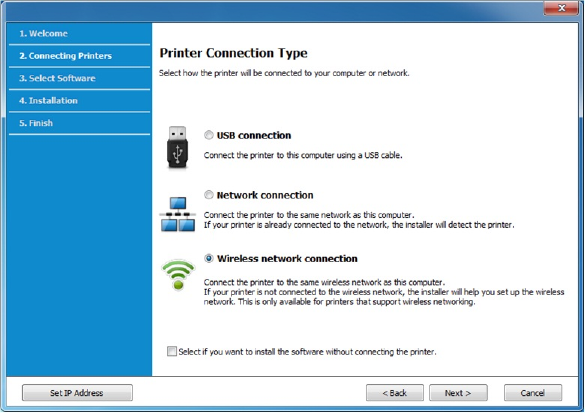
-
On the screen, select Then, click .
If your printer is already connected on the network, select .
-
Select on the screen. Then, click .
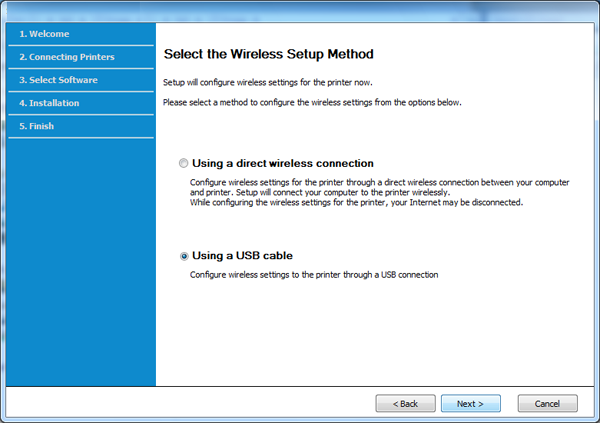
-
After searching, the window shows the wireless network devices. Select the name (SSID) of the access point you want to use and click .
![[Note]](../../common/icon_note.png)
If you cannot find the network name you want to choose, or if you want to set the wireless configuration manually, click .
-
: Enter the SSID of the access point (SSID is case-sensitive).
-
: Select .
-
: Select an authentication type.
: Authentication is not used, and encryption may or may not be used, depending on the need for data security.
: Authentication is used. A device that has a proper WEP key can access the network.
or : Select this option to authenticate the print server based on a WPA Pre-Shared Key. This uses a shared secret key (generally called Pre Shared Key pass phrase), which is manually configured on the access point and each of its clients.
-
: Select the encryption (None, WEP64, WEP128, TKIP, AES, TKIP AES).
-
: Enter the encryption network password value.
-
: Confirm the encryption network password value.
-
: If you are using WEP Encryption, select the appropriate .
![[Note]](../../common/icon_note.png)
The wireless network security window appears when the access point has security settings.
Enter the Network Password of the access point (or router).
-
-
If your printer supports Wi-Fi Direct and this function is disabled, its corresponding screen will appear.
Click .
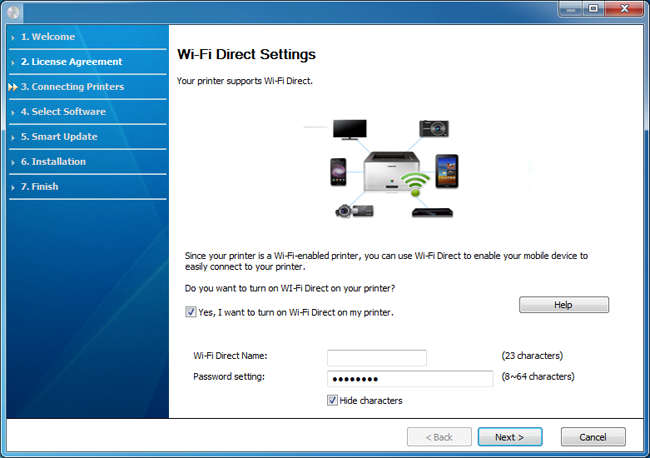
![[Note]](../../common/icon_note.png)
-
Wi-Fi Direct option appears on the screen only if your printer supports this feature.
-
Can start to build Wi-Fi Direct by using Samsung Easy Printer Manager (see Setting up Wi-Fi Direct).
-
: The default Wi-Fi Direct Name is the model name and the maximum length is 22 characters.
-
is the numeric string, and the size is 8 ~ 64 characters.
-
-
When the wireless network set up is completed, disconnect the USB cable between the computer and machine. Click .
-
Follow the instructions in the installation window.
Items to prepare
-
WiFi-enabled PC running Windows 7 or higher and an access point (router)
-
Software CD that was provided with your machine
-
A machine installed with a wireless network interface
|
|
|
|
While setting the wireless network, the machine uses PC's wireless LAN. You might not be able to connect to the Internet. |
Creating the infrastructure network
-
Turn on your computer, access point, and machine.
-
Insert the supplied software CD into your CD-ROM drive.

If the installation window does not appear, click > > > .
X:\ replacing “X” with the letter, which represents your CD-ROM drive and click .
-
Review and accept the installation agreements in the installation window. Then, click .
-
Select on the screen. Then, click .

-
On the screen, select Then, click .
If your printer is already connected on the network, select .
-
Select on the screen. Then, click .
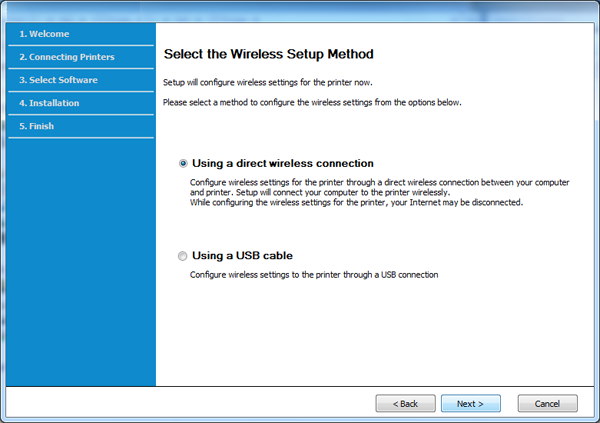
![[Note]](../../common/icon_note.png)
Even if your computer is running Windows 7 or higher, you cannot use this feature if your PC does not support wireless network. Set the wireless network using a USB cable (see Access point via USB cable).
If below screen appears, press the
 (WPS) button
from the control panel within 2 minutes.
(WPS) button
from the control panel within 2 minutes.
-
When the wireless network set up is completed, click .
-
Follow the instructions in the installation window.
Ad hoc via USB cable
If you do not have an access point (AP), you may still connect the machine wirelessly to your computer by setting up an ad-hoc wireless network by following the simple steps below.
Items to prepare
-
Network-connected computer
-
Software CD that was provided with your machine
-
A machine installed with a wireless network interface
-
USB cable
Creating the ad hoc network in Windows
-
Turn on your computer and the wireless network machine.
-
Insert the supplied software CD into your CD-ROM drive.

If the installation window does not appear, click > > > .
X:\ replacing “X” with the letter, which represents your CD-ROM drive and click .
-
Review and accept the installation agreements in the installation window. Then, click .
-
Select on the screen. Then, click .

-
On the screen, select Then, click .
If your printer is already connected on the network, select .
-
Select on the screen. Then, click .
-
After searching the wireless networks, a list of wireless networks your machine has searched appears. Click .
![[Note]](../../common/icon_note.png)
-
: Enter the SSID name you want (SSID is case-sensitive).
-
: Select ad hoc.
-
: Select the channel. ( or 2412 MHz to 2467 MHz).
-
: Select an authentication type.
: Authentication is not used, and encryption may or may not be used, depending on the need for data security.
: Authentication is used. A device that has a proper WEP key can access the network.
-
: Select the encryption (None, WEP64, WEP128).
-
: Enter the encryption network password value.
-
: Confirm the encryption network password value.
-
: If you are using WEP Encryption, select the appropriate .
The wireless network security window appears when the ad hoc network has security enabled.
Select or for the authentication and click .
-
WEP (Wired Equivalent Privacy) is a security protocol preventing unauthorized access to your wireless network. WEP encrypts the data portion of each packet exchanged on a wireless network using a 64-bit or 128-bit WEP encryption key.
-
-
The window showing the wireless network setting appears. Check the settings and click .
![[Note]](../../common/icon_note.png)
Before entering the IP address for the machine, you must know the computer’s network configuration information. If the computer’s network configuration is set to DHCP, the wireless network setting should also be DHCP. Likewise, if the computer’s network configuration is set to Static, the wireless network setting should also be Static.
If your computer is set to DHCP and you want to use the Static wireless network setting, you must contact the network administrator to get the static IP address.
-
For the DHCP method
If the IP address assignment method is DHCP, check if DHCP is shown in the window. If it shows Static, click to change the assignment method to .
-
For the Static method
If the IP address assignment method is Static, check if Static is shown in the window. If it shows DHCP, click to enter the IP address and other network configuration values for the machine.
For example,
If the computer’s network information is as shown follows:
-
IP address: 169.254.133.42
-
Subnet Mask: 255.255.0.0
Then, the machine’s network information should be as below:
-
IP address: 169.254.133.43
-
Subnet Mask: 255.255.0.0 (Use the computer’s subnet mask.)
-
Gateway: 169.254.133.1
-
-
-
The window appears. Click .
-
When the wireless network settings are completed, disconnect the USB cable between the computer and machine. Click .
-
Follow the instructions in the installation window.
Setup using Mac
Access point via USB cable
Items to prepare
-
Access point
-
Network-connected printer
-
Software CD that was provided with your machine
-
A machine installed with a wireless network interface
-
USB cable
-
Make sure that the machine is connected to your computer andpowered on.
-
Insert the supplied software CD into your CD-ROM drive.

-
Double-click the CD-ROM icon that appears on your Mac desktop.
-
For Mac OS X 10.8, double-click the CD-ROM that appears on .
-
-
Double-click the folder > icon.
-
Click .
-
Read the license agreement and click .
-
Click to agree to the license agreement.
-
Click . All components necessary for machine operations will be installed.
If you click , you can choose individual components to install.
-
Enter the password and click .
-
Select on the and click .
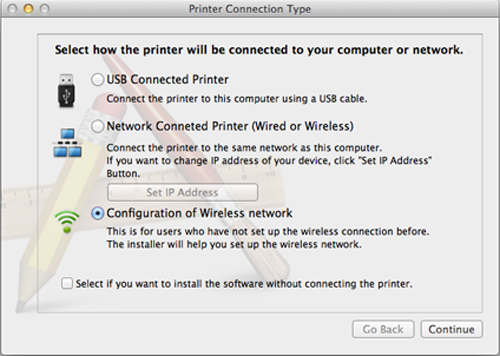
-
If screen appears, select and click .
If the screen does not appear, go to step 15.
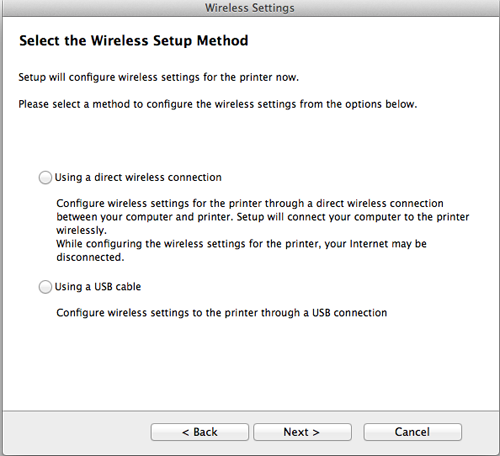
-
After searching, the window shows the wireless network devices. Select the name (SSID) of the access point you want to use and click .
![[Note]](../../common/icon_note.png)
When you set the wireless configuration manually, click .
-
: Enter the SSID of the access point (SSID is case-sensitive).
-
: Select .
-
: Select an authentication type.
: Authentication is not used, and encryption may or may not be used, depending on the need for data security.
: Authentication is used. A device that has a proper WEP key can access the network.
or : Select this option to authenticate the print server based on the WPA Pre-Shared Key. This uses a shared secret key (generally called Pre Shared Key pass phrase) that is manually configured on the access point and each of its clients.
-
: Select the encryption. (None, WEP64, WEP128, TKIP, AES, TKIP, AES)
-
: Enter the encryption network password value.
-
: Confirm the encryption network password value.
-
: If you are using WEP Encryption, select the appropriate .
The wireless network security window appears when the access point has security enabled.
Enter the Network Password of the access point (or router).
-
-
The window showing the wireless network setting appears. Check the settings and click .
![[Note]](../../common/icon_note.png)
-
Wi-Fi Direct option appears on the screen only if your printer supports this feature.
-
Can start to build Wi-Fi Direct by using Samsung Easy Printer Manager (see Setting up Wi-Fi Direct).
-
: The default Wi-Fi Direct Name is the model name and the maximum length is 22 characters.
-
is the numeric string, and the size is 8 ~ 64 characters.
-
-
The window appears. Click .
-
When the wireless network settings are completed, disconnect the USB cable between the computer and machine. Click .
Access point without a USB cable (recommended)
Items to prepare
-
WiFi-enabled Mac running Mac OS 10.7 or higher and an access point (router)
-
Software CD that was provided with your machine
-
A machine installed with a wireless network interface
-
Make sure that the machine is connected to your computer andpowered on.
-
Insert the supplied software CD into your CD-ROM drive.

-
Double-click the CD-ROM icon that appears on your Mac desktop.
-
For Mac OS X 10.8, double-click the CD-ROM that appears on .
-
-
Double-click the folder > icon.
-
Click .
-
Read the license agreement and click .
-
Click to agree to the license agreement.
-
Click . All components necessary for machine operations will be installed.
If you click , you can choose individual components to install.
-
Enter the password and click .
-
Select on the and click .

-
If screen appears, select and click .
If the screen does not appear, go to step 13.

![[Note]](../../common/icon_note.png)
If below screen appears, press the
 (WPS) button
from the control panel within 2 minutes.
(WPS) button
from the control panel within 2 minutes.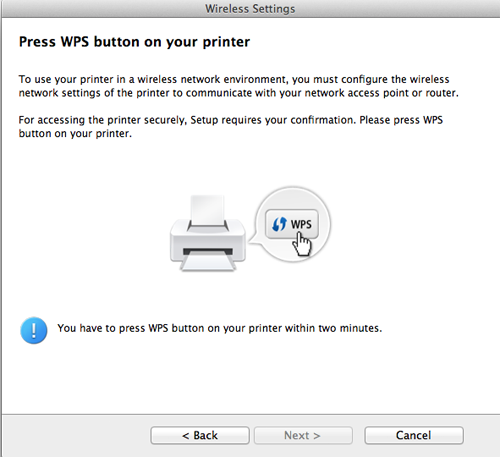
-
When the wireless network set up is completed, click .
-
After the installation is finished, click .
Ad hoc via USB cable
If you do not have an access point (AP), you may still connect the machine wirelessly to your computer by setting up an ad hoc wireless network by following these simple directions.
Items to prepare
-
Network-connected computer
-
Software CD that was provided with your machine
-
A machine installed with a wireless network interface
-
USB cable
Creating the ad hoc network in Mac
-
Make sure that the machine is connected to your computer andpowered on.
-
Insert the supplied software CD into your CD-ROM drive.

-
Double-click the CD-ROM icon that appears on your Mac desktop.
-
For Mac OS X 10.8, double-click the CD-ROM that appears on .
-
-
Double-click the folder > icon.
-
Click .
-
Read the license agreement and click .
-
Click to agree to the license agreement.
-
Click . All components necessary for machine operations will be installed.
If you click , you can choose individual components to install.
-
Enter the password and click .
-
Select on the and click .

-
After searching the wireless networks, a list of wireless networks your machine has searched appears. Click .
![[Note]](../../common/icon_note.png)
-
: Enter the SSID name (SSID is case-sensitive).
-
: Select ad hoc.
-
: Select the channel ( or 2412 MHz to 2467 MHz).
-
: Select an authentication type.
: Authentication is not used, and encryption may or may not be used, depending on the need for data security.
: Authentication is used. A device that has a proper WEP key can access the network.
-
: Select the encryption (None, WEP64, WEP128).
-
: Enter the encryption network password value.
-
: Confirm the encryption network password value.
-
: If you are using WEP Encryption, select the appropriate .
The wireless network security window appears when the ad hoc network has security setting.
Select or for the authentication and click .
-
WEP (Wired Equivalent Privacy) is a security protocol preventing unauthorized access to your wireless network. WEP encrypts the data portion of each packet exchanged on a wireless network using a 64-bit or 128-bit WEP encryption key.
-
-
The window showing the wireless network settings appears. Check the settings and click .
![[Note]](../../common/icon_note.png)
Before entering the IP address for the machine, you must know the computer’s network configuration information. If the computer’s network configuration is set to DHCP, the wireless network setting should also be DHCP. Likewise, if the computer’s network configuration is set to Static, the wireless network setting should also be Static.
If your computer is set to DHCP and you want to use Static wireless network setting, you must contact the network administrator to get the static IP address.
-
For the DHCP method
If the IP address assignment method is DHCP, check if DHCP is shown in the window. If it shows Static, click to change the assignment method to .
-
For the Static method
If the IP address assignment method is Static, check if Static is shown in the window. If it shows DHCP, click to enter the IP address and other network configuration values for the machine.
For example,
If the computer’s network information is shown as follows:
-
IP address: 169.254.133.42
-
Subnet Mask: 255.255.0.0
Then, the machine’s network information should be as shown below:
-
IP address: 169.254.133.43
-
Subnet Mask: 255.255.0.0 (Use the computer’s subnet mask.)
-
Gateway: 169.254.133.1
-
-
-
When the window that tells you that the network cable connection is confirmed appears, disconnect the network cable and click .
If the network cable is connected, it may have trouble finding the machine when configuring the wireless network.
-
The wireless network connects according to the network configuration.
-
Wireless network set up is completed. After installation is finished, click .
![[Note]](../../common/icon_note.png)
After completing the wireless network connection, you need to install a machine driver to print from an application (see Installation for Mac).
|
|
|
|
Machines that do not support the network interface will not be able to use this feature (see Rear view). |
Your machine is a network compatible machine. To enable your machine to work with your network, you will need to perform some configuration procedures.
|
|
|
|
Items to prepare
-
Access point
-
Network-connected computer
-
Software CD that was provided with your machine
-
A machine installed with a wireless network interface
-
Network cable
Printing a network configuration report
You can identify the network settings of your machine by printing a network configuration report.
This program is used to manually set the network IP address of your machine using its MAC address to communicate with the machine. The MAC address is the hardware serial number of the network interface and can be found in the Network Configuration Report.
See Setting IP address.
Configuring the machine’s wireless network
Before starting you will need to know the network name (SSID) of your wireless network and the network key if it is encrypted. This information was set when the access point (or wireless router) was installed. If you do not know about your wireless environment, please ask the person who set up your network.
To configure wireless parameters, you can use .
Using SyncThru™ Web Service
Before starting wireless parameter configuration, check the cable connection status.
-
Check whether or not the network cable is connected to the machine. If not, connect the machine with a standard network cable.
-
Start a web browser such as Internet Explorer, Safari, or Firefox and enter your machine’s new IP address in the browser window.
For example,

-
Click on the upper right of the SyncThru™ Web Service website.
-
If it’s your first time logging into you need to log-in as an administrator. Type in the below default ID and password. We recommend you to change the default password for security reasons.
-
:
-
:
-
-
When the window opens, click .
-
Click > .
![[Note]](../../common/icon_note.png)
will help you setup the wireless network configuration. However, if you want to set the wireless network directly, select .
-
Select the one in the list.
-
: SSID (Service Set Identifier) is a name that identifies a wireless network, access points, and wireless devices attempting to connect to a specific wireless network must use the same SSID. The SSID is case sensitive.
-
: refers to the type of wireless connections (see Wireless network name and network password).
-
: Allows wireless devices to communicate directly with each other in a peer-to-peer environment.
-
: Allows wireless devices to communicate with each other through an access point.
-
![[Note]](../../common/icon_note.png)
If your network’s is , select the SSID of the access point. If the is , select the machine’s SSID.
-
-
Click .
If the wireless security setting window appears, enter the registered password (network password) and click .
-
The confirmation window appears, please check your wireless setup. If the setup is right, click .
![[Caution]](../../common/icon_caution.png)
Disconnect the network cable (standard or network). Your machine should then start communicating wirelessly with the network. In case of Ad-hoc mode, you can use a wireless LAN and wired LAN simultaneously.
-
Insert the supplied software CD into your CD-ROM drive, and follow the instructions in the window to set up the wireless network.
Turning the Wi-Fi network on/off
|
|
|
|
If your machine has a display, you can also turn on/off the Wi-Fi from the machine’s control panel using the menu. |
-
Check whether the network cable is connected to the machine. If not, connect the machine with a standard network cable.
-
Start a web browser such as Internet Explorer, Safari, or Firefox and enter your machine’s new IP address in the browser window.
For example,

-
Click on the upper right of the SyncThru™ Web Service website.
-
If it’s your first time logging into you need to log-in as an administrator. Type in the below default ID and password. We recommend you to change the default password for security reasons.
-
:
-
:
-
-
When the window opens, click .
-
Click > .
You can also turn the Wi-Fi network on/off.
Setting the Wi-Fi Direct for mobile printing
Wi-Fi Direct is an easy-to-setup peer-to-peer connection method between the Wi-Fi Direct certified printer and a mobile device that provides a secure connection and better throughput than ad hoc mode.
With Wi-Fi Direct, you can connect your printer to a Wi-Fi Direct network while concurrently connecting to an access point. You can also use a wired network and a Wi-Fi Direct network simultaneously so multiple users can access and print documents both from Wi-Fi Direct and from a wired network.
|
|
|
|
Setting up Wi-Fi Direct
You can enable Wi-Fi Direct feature by one of the following methods.
From the USB cable-connected computer (recommended)
After the driver installation is complete, Samsung Easy Printer Manager can be used to change Wi-Fi Direct settings.
|
|
|
|
Samsung Easy Printer Manager is Available for Windowsand Mac OS users only. |
-
From the menu, select or > > Samsung Easy Printer Manager > > .
-
: Select to enable.
-
: Enter the printer’s name for searching for your printer on a wireless network. By default, the device name is the model name.
-
: Enter the IP address of the printer. This IP address is used only for the local network and not for the infrastructure wired or wireless network. We recommend using the default local IP address (the default local IP address of the printer for Wi-Fi Direct is 192.168.3.1)
-
: Activate this option to assign the printer the Wi-Fi Direct group’s owner. The acts similar to a wireless access point. We recommend activating this option.
-
: If your printer is a , a is required for other mobile devices to connect to your printer. You can configure a network password yourself, or can remember the given Network Password that is randomly generated by default.
-
From the machine (Machines with a display screen)
-
Select > > from the control panel.
-
Enable .
From the machine (Machines without a display screen)
-
Press and hold the
 (WPS) button
on the control panel for about 10- 15 seconds. Wi-Fi
Direct feature turns on.
(WPS) button
on the control panel for about 10- 15 seconds. Wi-Fi
Direct feature turns on. -
Press and hold the
 (WPS) button
on the control panel for more than 15 seconds. Wi-Fi
Direct feature turns off.
(WPS) button
on the control panel for more than 15 seconds. Wi-Fi
Direct feature turns off.
From the network-connected computer
If your printer is using a network cable or a wireless access point, you can enable and configure Wi-Fi Direct from SyncThru™ Web Service.
-
Access , select > > > .
-
Enable or disable and set other options.
|
|
|
|
Setting up the mobile device
-
After setting up Wi-Fi Direct from the printer, refer to the user manual of the mobile device you are using to set its Wi-Fi Direct.
-
After setting up Wi-Fi Direct, you need to download the mobile printing application (For example: Samsung Mobile printer) to print from your smartphone.
|
|
|
|
Troubleshooting
Problems during setup or driver installation
-
Your machine may not be turned on. Turn on your computer and the machine.
-
USB cable is not connected between your computer and machine. Connect the machine to your computer using the USB cable.
-
The machine does not support wireless networking. Check the machine's user's guide included on the software CD supplied with your machine and prepare a wireless network machine.
-
-
The machine is unable to find the network name (SSID) you have selected or entered. Check the network name (SSID) on your access point and try connecting again.
-
Your access point is not turned on. Turn on your access point.
-
-
Security is not configured correctly. Check the configured security on your access point and machine.
-
-
Your computer is not receiving a signal from your machine. Check the USB cable and your machine’s power.
-
-
Your machine is connected with a wired network cable. Remove the wired network cable from your machine.
-
-
Cycle the power for the access point (or wireless router) and machine.
-
The configured network address is unable to connect between your computer and machine.
-
For a DHCP network environment
The receives the IP address automatically (DHCP) when computer is configured to DHCP.
![[Note]](../../common/icon_note.png)
If the printing job is not working in DHCP mode, the problem may be caused by the automatically changed IP address. Compare the IP address between the product's IP address and the printer port's IP address.
How to compare:
-
Print the network information report of your printer, and then check the IP address (see Printing a network configuration report).
-
Check the printer port's IP address from your computer.
-
Click the Windows menu.
-
For Windows XP/Server 2003, select .
-
For Windows Server 2008/Vista, select > > .
-
For Windows 7, select > .
-
For Windows Server 2008 R2, select > > .
-
-
Right-click your machine.
-
For Windows XP/2003/2008/Vista, press .
For Windows 7 and Windows Server 2008 R2, from context menus, select the .
If item has ► mark, you can select other printer drivers connected with selected printer.
-
Click tab.
-
Click button.
-
Check if or is the IP address on the network configuration Sheet.
-
-
Change the printer port's IP address if it is different from the network information report's.
If you want to use the software installation CD to change the port IP, connect to a network printer. Then reconnect the IP address.
-
-
For a Static network environment
The machine uses the static address when the computer is configured to static address.
For example,
If the computer’s network information is as shown below:
-
IP address: 169.254.133.42
-
Subnet Mask: 255.255.0.0
Then the machine’s network information should be as below:
-
IP address: 169.254.133.43
-
Subnet Mask: 255.255.0.0 (Use the computer’s subnet mask.)
-
Gateway: 169.254.133.1
-
-
Other problems
If problems occur while using the machine on a network, check the following:
|
|
|
|
For information on the access point (or wireless router), refer to its own user's guide. |
-
You cannot enable wired and wireless networks at the same time.
-
Your computer, access point (or wireless router), or machine may not be turned on.
-
Check the wireless reception around the machine. If the router is far from the machine or there is an obstacle, you might have difficulty receiving the signal.
-
Cycle the power for the access point (or wireless router), machine, and computer. Sometimes cycling the power can recover network communication.
-
Check whether firewall software (V3 or Norton) is blocking the communication.
If the computer and the machine are connected on the same network and it cannot be found when searching, firewall software might be blocking the communication. Refer to the user's guide for the software to turn it off and try searching for the machine again.
-
Check whether the machine's IP address is allocated correctly. You can check the IP address by printing the network configuration report.
-
Check whether the access point (or wireless router) has a configured security (password). If it has a password, refer to the access point (or wireless router) administrator.
-
Check the machine's IP address. Reinstall the machine driver and change the settings to connect to the machine on the network. Due to the characteristics of DHCP, the allocated IP address could change if the machine is not used for a long time or if the access point has been reset.
Register the product's MAC address when you configure the DHCP server on the access point (or wireless router). Then you can always use the IP address that is set with the MAC address. You can identify the Mac address of your machine by printing a network configuration report (see Printing a network configuration report).
-
Check the wireless environment. You might not be able to connect to the network in the infrastructure environment where you need to type in a user's information before connecting to the access point (or wireless router).
-
This machine only supports IEEE 802.11 b/g/n and Wi-Fi. Other wireless communication types (e.g., Bluetooth) are not supported.
-
When using the ad hoc mode, in operating systems such as Windows Vista, you might need to set the wireless connection setting every time you use the wireless machine.
-
You cannot use infrastructure mode and ad hoc mode at the same time for Samsung wireless network machines.
-
The machine is within the range of the wireless network.
-
The machine is located away from obstacles that could block the wireless signal.
Remove any large metal objects between the access point (or wireless router) and the machine.
Make sure the machine and wireless access point (or wireless router) are not separated by poles, walls, or support columns containing metal or concrete.
-
The machine is located away from other electronic devices that may interfere with the wireless signal.
Many devices can interfere with the wireless signal, including a microwave oven and some Bluetooth devices.
-
Whenever the configuration of your access point (or wireless router) changes, you must do the product's wireless network setup again.
-
The maximum number of devices that can be connected via is 3.
-
If is , this machine only supports IEEE 802.11 b/g.
-
If the access point is set to work with the 802.11n standard only, it may not connect to your machine.

